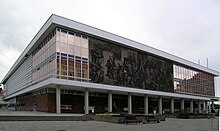Leopold Wiel
Leopold Wiel (born May 14, 1916 in Barmen , today Wuppertal-Barmen) is a German architect and university professor , known among other things for his design for the Dresden Palace of Culture .
Life
Leopold Wiel studied from 1934 to 1940 at the Higher Technical College for Civil Engineering in Barmen and at the University of Architecture and Fine Arts in Weimar . From 1940 to 1945 he served in World War II and was wounded in Stalingrad . Shortly before the bombing of Dresden , he experienced the city on a home leave.
From 1945 to 1951 he worked as a freelance architect in Weimar and was employed as a university lecturer at the Weimar University. Following the suggestion of Heinrich Rettig , Wiel was appointed professor for technical studies , building construction theory, housing construction and design at the Dresden University of Technology in 1951 , where he taught until 1981. From 1965 to 1967 Wiel was the dean of the Faculty of Civil Engineering at the Technical University of Dresden and in 1968 became director of the Institute for Structural Engineering of the Faculty of Civil Engineering. In 1971 he was awarded an honorary doctorate from the Budapest University of Technology . He retired in 1981. In 1994 he became an honorary member of the Saxon Chamber of Architects and was a long-time member of the German Standards Committee . His work Building Constructions of Housing is still considered a standard work for architecture students today and had twelve editions by 2006.
Wiel lives with his second wife Christa on the Weißer Hirsch .
Kulturpalast Dresden
On December 1, 1959, an architectural competition for a house of socialist culture in Dresden was announced. Contrary to the ideas of the SED leadership in the city, Wiel's proposal did not contain a tower house and was rejected. As a result, three other design groups received orders in 1960 to further develop their proposals. In the fall of 1961, a delegation from the SED city leadership traveled from Dresden to Moscow to present the best proposals to the architecture faculty. Here, Wiel's suggestion was used as a negative example. To the surprise of the SED delegation, the Moscow officials decided in favor of Wiel's proposal as the only possible one. Thereupon the 1st secretary of the SED city administration apologized to Wiel and gave him the order to develop a final draft based on his competition entry. Since Wiel was too tied up in his teaching activities as a professor at the TU Dresden at that time, he handed his plans over to the Dresden architect Wolfgang Hänsch , who developed a new design based on Wiel's designs, which was put into practice from 1966 were. The execution planning was also taken over by Wolfgang Hänsch as chief architect and Herbert Löschau.
plant
buildings
- Projects for the Stadtwerke in Weimar, 1945–1951
- architectural planning of the Kulturpalast Dresden , 1959–1960
- Planning for the reconstruction of the Taschenbergpalais
Fonts
- 1954: Building construction using the scale in building construction
- 1967: Construction of residential buildings
literature
- Manfred Zumpe : an architect with integrity and a university professor. Prof. em. Dr. hc Leopold Wiel on his 90th birthday. In: Dresdner Universitätsjournal 17th year 2006, No. 8, p. 8 ( online as PDF; 0.9 MB).
- Susann Buttolo : The book on »Wiel«. Leopold Wiel for the hundredth . Sandstein Verlag, Dresden 2016, ISBN 978-3-95498-234-9 .
Web links
- Dresden and its architects currents and tendencies 1900 - 1970 - portrait of Wiels on das-neue-dresden.de ( Memento from October 11, 2007 in the Internet Archive ) (PDF; 638 kB)
Individual evidence
- ↑ a b Bettina Klemm: Kulturpalast architect celebrates 100th birthday. In: Sächsische Zeitung online. May 14, 2016, accessed April 13, 2020 .
- ↑ Manfred Zumpe : An architect with integrity and a university professor . In: Dresdner Universitätsjournal , No. 8, 2006, p. 8 ( online as PDF; 0.9 MB).
- ↑ Wolfgang Hänsch - Architect of Dresden Modernism - Edited by Wolfgang Kil, Verlag form + Zweck, Berlin 2009
- ↑ History of the Kulturpalast Dresden received at the Kulturpalast Dresden
| personal data | |
|---|---|
| SURNAME | Wiel, Leopold |
| BRIEF DESCRIPTION | German architect and university professor |
| DATE OF BIRTH | May 14, 1916 |
| PLACE OF BIRTH | Barmen |
